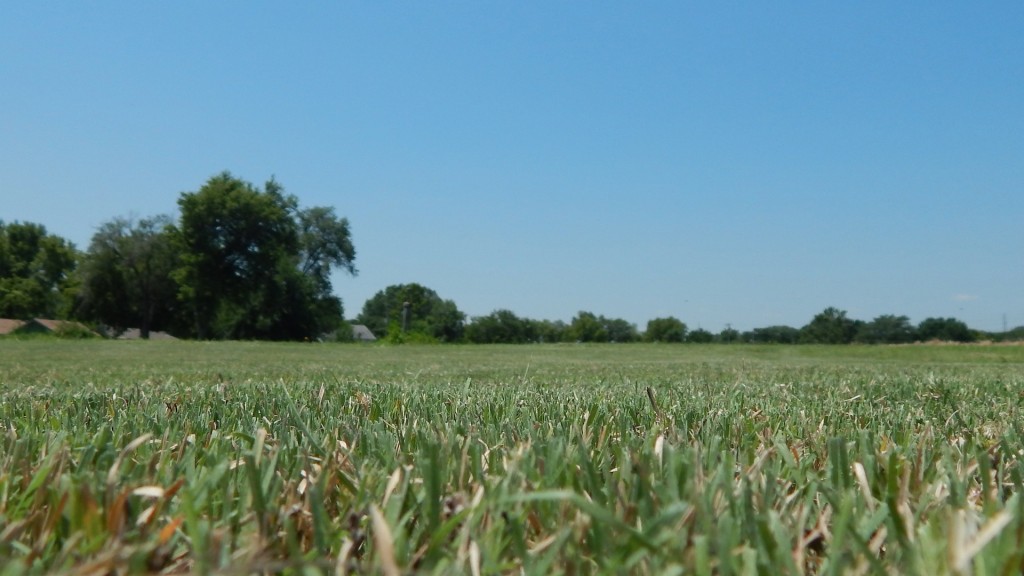(By Jake Reeves and Jared Hoyle, KSU Turfgrass Research and Extension)

Water restrictions and increased interest in sustainability are driving many golf course superintendents to consider new ways to save. Ironically, one of the best new fits for saving in Kansas is one of the oldest ways around: buffalograss. Buffalograss (Buchloe dactyloides) is actually the only widely used turfgrass native to North America. Many of the recent cultivars (Sharp’s Improved II, Bowie) grow denser and greener than their predecessors while not sacrificing their drought/cold tolerance, disease resistance, and other great characteristics. Traffic intolerance is one of the largest concerns for many superintendents, but a little traffic management can go a long way especially if coupled with cart paths. While not a perfect fit for every situation, buffalograss requires very little water, less mowing, and minimal nitrogen input to achieve an acceptable stand.
 It is these characteristics that have many courses considering replacing their tall fescue roughs with buffalograss. Once established, the courses could divert the money and time previously spent on their roughs to tees, fairways, and greens, ultimately rewarding a well-played round.
It is these characteristics that have many courses considering replacing their tall fescue roughs with buffalograss. Once established, the courses could divert the money and time previously spent on their roughs to tees, fairways, and greens, ultimately rewarding a well-played round.
The end product is exciting for many superintendents, as their water bills would shrink. However, going through long periods of closing the course for renovations isn’t appealing to already cash-strapped courses. Minimizing downtime and maximizing germination success with buffalograss seeding is a must if a course wanted to reduce the financial impact of the process.
We wanted to look at the most effective form of renovation from tall fescue roughs to buffalograss roughs without tilling the soil. This was to allow play to continue as long as possible on the course and keeping the renovation process very feasible for most courses. Examining 3 different mowing heights and 4 different cultivation practices, our results will provide the most time and cost effective method for end users.
 We are comparing a zero cultivation practice, aerification(2x), verticutting(2x), and slit seeding(2x @ 2lbs/M each pass) against the 3 mowing heights (2.5”, 1.75”, 1.25”). All cultivation practices except for slit-seeding were broadcast with Sharp’s Improved II buffalograss seed at 4 lbs/1000 ft2. Traditionally, it is recommended that buffalograss seed be soaked for 3 days, changing the water every day, to encourage a quick germination upon seeding. However, we did not soak the seed, believing the process not to be practical if a course was truly reseeding all of their rough.
We are comparing a zero cultivation practice, aerification(2x), verticutting(2x), and slit seeding(2x @ 2lbs/M each pass) against the 3 mowing heights (2.5”, 1.75”, 1.25”). All cultivation practices except for slit-seeding were broadcast with Sharp’s Improved II buffalograss seed at 4 lbs/1000 ft2. Traditionally, it is recommended that buffalograss seed be soaked for 3 days, changing the water every day, to encourage a quick germination upon seeding. However, we did not soak the seed, believing the process not to be practical if a course was truly reseeding all of their rough.
Our results to date have shown that slit-seeding was the most successful method by far with aerification, verticutting, and zero cultivation decreasing in effectiveness in that order. Slit-seeding mowed at 1.25” and 1.75” reached 100% cover 6 weeks after seeding (WAS) with minimal weed encroachment. Ultimately, mowing height has had no effect except for a very slight lag in plots mowed at 2.5” compared to the two lowers heights. We hope to continue looking at fescue removal and buffalograss seeding in order to shorten the green cover loss experienced in the renovation process.

